
2001 Honda Civic Preview
A First Impression
By Larkin Hill
 Hi! I'm Jennifer. I'm in my mid-twenties. I'm college educated, just starting my career, and living on my own (ok, so I have one roommate). I just bought a brand new Honda Civic Coupe.
Hi! I'm Jennifer. I'm in my mid-twenties. I'm college educated, just starting my career, and living on my own (ok, so I have one roommate). I just bought a brand new Honda Civic Coupe.
"Good for you," you say, "But who cares?" Well, Honda does. And why? Because according to Honda, I'm a typical "Gen X'er"/"Boomlet Single," and I'm Honda's largest buyer segment for the Civic Coupe.
Civics are sensible cars that are both good-looking and reliable. And they've been earning that enviable reputation for nearly three decades.

They're sporty, economic, and low-maintenance. Oil changes and regular check-ups are just about all that a Civic will need -- and that's a good thing, because the average "Boomlet" buyer doesn't want to waste time on their cars. That's not to be mistaken with the idea that Civic owners don't care about their vehicles, it just means that they want something that won't require much additional maintenance -- they've got better things to do with their life than to make "surprise" visits their local mechanics. They want something that will economically and comfortably take them from A to B and back, with the freedom to take them to Z and X, and even to Q -- if they so desire.
In 1973 Honda brought this responsible freedom to the American consumer with their CVCC. It immediately shot to the top of the EPA mileage list. Seven years later, in 1980, the larger second generation was introduced. A sedan was added to the lineup in 1981. 1984 brought the third generation Civic and the addition of the popular, sporty, and now extinct CRX. In 1988 the fourth generation Civic began production in the US -- and it, once again, grew in size. 1992 brought the fifth generation body style, SOHC VTEC/VTEC-E engines, and the addition of the 1993 Coupe and del Sol. At the forefront of their category, the sixth generation Civic becomes the best selling small car in 1996 and in 1997 it achieved the honor of being the first gasoline powered LEV vehicle in all 50 states.
Now, for 2001, the seventh generation Civic is even more of a car -- literally. It's bigger, more luxurious, and safer than ever before. In fact, it almost qualifies for the compact car category.
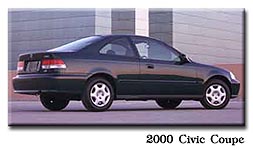
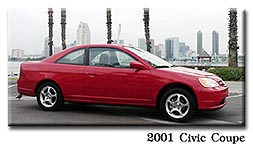
Introduced with two distinctive body styles, the all-new 2001 Honda Civic targets to two different demographic markets. The Coupe is for the "Jennifer's" of North America, while the sedan comfortably accommodates small families and couples hovering around the age of 30. Of course, these are simply assumptions and people of all ages, economic standings, and intelligence purchase both the Coupe and Sedan.
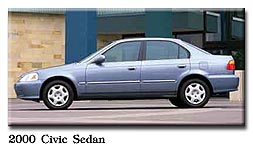
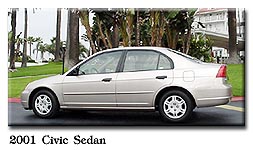
 While the exterior is notably different than the 6th generation Civics, the most impressive and significant changes occurred on the inside. According to Chief Engineer, Katsunori Mori, the designer's primary objective with the 7th generation Civics was "maximizing passenger space." And that they did.
While the exterior is notably different than the 6th generation Civics, the most impressive and significant changes occurred on the inside. According to Chief Engineer, Katsunori Mori, the designer's primary objective with the 7th generation Civics was "maximizing passenger space." And that they did.

To introduce the next-generation Civic, Honda flew a bunch of journalists to San Diego to take it for a spin. Cruising alongside numerous other generations of Civics on the sunny streets of the Southern California City, the 2001 Coupes and Sedans were easily distinguishable from their older siblings.
Passenger volume for the Coupe went from 82.6 to 86 cubic feet and 86.5 to 91.4 cubic feet in the Sedan. Trunk space in both went from 11.9 to 12.9 cubic feet. Yet, while the seventh generation interior is more spacious, the most impressive change is the upgraded styling.
 Visibly there's a higher grade of materials on the dash and side molding and an entirely new instrument panel that gives it a much smoother, richer, and classier look. The surface of the Coupe has a metallic sheen that makes it feel sportier and trendier feel. The sedan works well with a higher-grade matte finish. In both models, the cloth is exceptionally soft, the panels are more solid feeling than before, and the panel seams are more refined. There are lager cupholders, a significantly larger footrest for the driver, and the seats are more comfortable.
Visibly there's a higher grade of materials on the dash and side molding and an entirely new instrument panel that gives it a much smoother, richer, and classier look. The surface of the Coupe has a metallic sheen that makes it feel sportier and trendier feel. The sedan works well with a higher-grade matte finish. In both models, the cloth is exceptionally soft, the panels are more solid feeling than before, and the panel seams are more refined. There are lager cupholders, a significantly larger footrest for the driver, and the seats are more comfortable.
During the brief stop for lunch, my driving partner and I were asked about the seat comfort. Momentarily without words, my partner and I had failed to think about seats, and as she quickly admitted our lack of awareness, it occurred to us that after two hours of driving the seats were so comfortable that we didn't have to think about them. They weren't too hard, too small, or oddly shaped, as is often the case in compact cars. In the redesign, the seats were raised for optimal hip-angling, have larger side bolsters, and were expanded both hip and lengthwise.
 There's more room throughout -- in both the coupe and sedan. In the Sedan, the increased volume is noticeably different and the most obvious increase in space involves the rear seat legroom. In keeping with Katsunori Mori's goal of maximizing passenger volume, Honda overhauled the Civics' suspension system. In the front, space saving MacPherson struts provide increased tire contact, which in turn, provided better handling. The rear has a refined double wishbone system that adds to the increased the trunk space, premium ride, and the "flat floor" rear seats. Because the new rear suspension was more compact than its predecessor, the design allowed the engineers to move the exhaust "pre-chamber" all the way back to the rear area, instead of the standard cabin floor location, thus leaving a "tunnel-less" bottom. More rear legroom and a cleaner look is the result. Now, sitting in the middle will no longer force your passengers to suffer the embarrassing "knee-knocking-spread-legs" or the uncomfortable "knees-to-the-chin" position.
There's more room throughout -- in both the coupe and sedan. In the Sedan, the increased volume is noticeably different and the most obvious increase in space involves the rear seat legroom. In keeping with Katsunori Mori's goal of maximizing passenger volume, Honda overhauled the Civics' suspension system. In the front, space saving MacPherson struts provide increased tire contact, which in turn, provided better handling. The rear has a refined double wishbone system that adds to the increased the trunk space, premium ride, and the "flat floor" rear seats. Because the new rear suspension was more compact than its predecessor, the design allowed the engineers to move the exhaust "pre-chamber" all the way back to the rear area, instead of the standard cabin floor location, thus leaving a "tunnel-less" bottom. More rear legroom and a cleaner look is the result. Now, sitting in the middle will no longer force your passengers to suffer the embarrassing "knee-knocking-spread-legs" or the uncomfortable "knees-to-the-chin" position.
 The steering wheel is thicker than the previous model, but still remains larger and skinnier than the VW Jetta and Ford Focus. Visibility is excellent from all seating positions in both the Coupe and Sedan and both feel more nimble than the comparably priced Saturn and firmer than the Kia Sephia. However, both the Jetta and Focus hug the road on turns more than the Civic Sedan. And, while both the Jetta and Focus feel like compact sedans, that seem to only fit small children in the back, the Civic Sedan easily accommodates four full size adults and three medium children.
The steering wheel is thicker than the previous model, but still remains larger and skinnier than the VW Jetta and Ford Focus. Visibility is excellent from all seating positions in both the Coupe and Sedan and both feel more nimble than the comparably priced Saturn and firmer than the Kia Sephia. However, both the Jetta and Focus hug the road on turns more than the Civic Sedan. And, while both the Jetta and Focus feel like compact sedans, that seem to only fit small children in the back, the Civic Sedan easily accommodates four full size adults and three medium children.
The overhaul also brought more peace to the Coupe and Sedan. Both are noticeably quieter than their predecessors are. The aluminum-allow in-line 4-cylinder engines come in three variations: the HX, DX and LX, or EX. All of the models have been bumped up from 1.6 to 1.7-liters, and have kept their high-pitched signature Civic sound. The EX receives the VTEC-E that produces 127 horsepower and 114 lbs-ft of torque, white the DX and LX get a single overhead cam (SOHC) that generates 115 horsepower and 110 pounds per feet of torque. Lastly, the HX has a VTEC-E lean burn that generates 117 horsepower and 111 pounds-feet of torque. However, the most pleasurable modification is the increase in torque at low rpm's in all vehicles, which produces a peppier ride
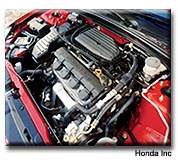
Reaching the LEV standard in 1998 was great, but for the 2001 line-up, Honda has brought benefits that will make both the environment and pocketbook smile. The 2001Civics all have improved fuel efficiency and reduce emissions. In fact, the 2001 Civic is the first vehicle to quality as a ULEV in all 50 states thanks to a higher density catalytic converter.
Safety features for the Civic are comparable to their competitors. Both the driver and passenger receive standard front airbags, while side airbags remain an option. In the rear, three 3-point seat belts are provided, as are child seat tether anchors. The rear sets have childproof door locks in the sedan and, most impressively, in both body styles an ISOFIX child anchorage system is standard. Honda's one year ahead of the required 2002 government mandated inclusion of this built in system that secures a baby's seat to the frame of the car.
Coupe
 Designed and developed exclusively for the US consumer, the Civic Coupe has been a staple vehicle for a large portion of the young American market. For 2001, the coupe has a lower profile and sportier appearance. Shorter with a more heavily raked front and rear windows than the sedan, the coupe sports tighter seams and a more stylish rear than ever before. Wraparound taillights, an angular trunk, and a distinctive grille separate it from the 2001 sedan and its predecessors. Yet, while the interior feels more spacious, the dimensions have not changed significantly.
Designed and developed exclusively for the US consumer, the Civic Coupe has been a staple vehicle for a large portion of the young American market. For 2001, the coupe has a lower profile and sportier appearance. Shorter with a more heavily raked front and rear windows than the sedan, the coupe sports tighter seams and a more stylish rear than ever before. Wraparound taillights, an angular trunk, and a distinctive grille separate it from the 2001 sedan and its predecessors. Yet, while the interior feels more spacious, the dimensions have not changed significantly.
Overall
It's larger, more refined, and quicker. In fact, the 2001 Civic is almost too nice to still be considered Honda's economy car. The 2001 Civic Sedan and Coupe uphold Honda's core values of "Dependability, Quality, and Reliability." With only a moderate price increase, the Civic remains an excellent value and a sensible choice for anyone -- even if you're not a "Jennifer."


